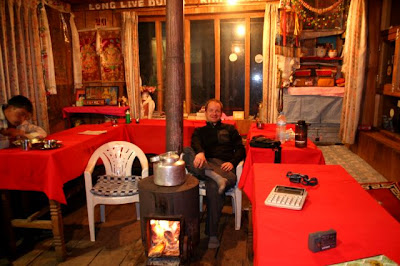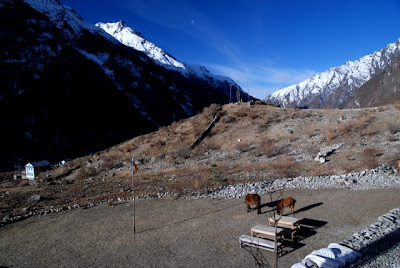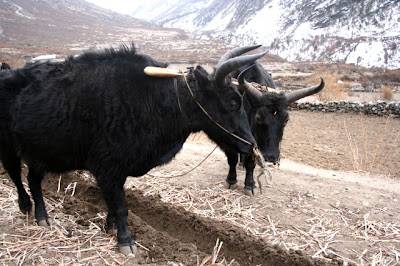After spending nearly a week in Kathmandu waiting for my bag to arrive, I was beyond ecstatic to finally be heading to the Himalaya.
Luckily, I also had an experienced partner in Carolyn.
The Langtang region lies about 100 km (62 miles) north of Kathmandu and borders Tibet-- the main trekking route lies approximately 15 km (9 miles) south of Tibet.
Langtang introduced me to the mountain region of Nepal and gave me a better understanding of the Nepalese, and, moreover, the Tibetan cultures. I can honestly say that I have never met a more friendly and giving people than those that I encountered in Langtang. I fell in love with the Nepalese and, especially, the Tibetan cultures in Langtang.
Langtang touched my heart like no other place that I can remember and introduced me to the largest obstacle facing Nepal going-forward-- education.
I carry the lessons that I learned from Langtang with me and hold them close to my heart.
Here are the photos from Carolyn and my trip to the Langtang region. Hopefully, a more detailed description of our journey will soon follow...
 A view of a terrace field from the bus. The entire bus journey to Syaphru Besi from Kathmandu winds around fields like this-- a very peaceful site.
A view of a terrace field from the bus. The entire bus journey to Syaphru Besi from Kathmandu winds around fields like this-- a very peaceful site. Syaphru Besi, the starting point of the Langtang trek.
Syaphru Besi, the starting point of the Langtang trek. A view of one of the many suspension bridges on the trek. (photo provided by Carolyn Boot)
A view of one of the many suspension bridges on the trek. (photo provided by Carolyn Boot) A local man weaving a basket. (Carolyn Boot)
A local man weaving a basket. (Carolyn Boot)
 Me showing the son of the owner of our first guesthouse, Evening View in Rimche, his photo. (Carolyn Boot)
Me showing the son of the owner of our first guesthouse, Evening View in Rimche, his photo. (Carolyn Boot) A typical Nepali kitchen on the trek (Evening View). Very simple, but very clean. The Nepali people take pride in their kitchens. In fact, most families also sleep in their kitchens, as it is normally the only room that is heated. (Carolyn Boot)
A typical Nepali kitchen on the trek (Evening View). Very simple, but very clean. The Nepali people take pride in their kitchens. In fact, most families also sleep in their kitchens, as it is normally the only room that is heated. (Carolyn Boot)

 A view of the mountains near Lama Hotel. (Carolyn Boot)
A view of the mountains near Lama Hotel. (Carolyn Boot) Galmun taking a break-- still knitting away. (Carolyn Boot)
Galmun taking a break-- still knitting away. (Carolyn Boot)

 The owner of the guest house in Chhunama and his newborn. (Carolyn Boot)
The owner of the guest house in Chhunama and his newborn. (Carolyn Boot) Galmun and her friends walking us toward Langtang. (Carolyn Boot)
Galmun and her friends walking us toward Langtang. (Carolyn Boot) Looking back toward the valley in Thyangsyapu.
Looking back toward the valley in Thyangsyapu.
 Relaxing fireside at the Eco Lodge in Langtang-- probably the best place to stay on the Langtang trail. (Carolyn Boot)
Relaxing fireside at the Eco Lodge in Langtang-- probably the best place to stay on the Langtang trail. (Carolyn Boot) The morning view from Eco Lodge.
The morning view from Eco Lodge. Galmun, her son, her sister and her sister's son at their house in Langtang. Galmun invited us to her house for tea and biscuits. (Carolyn Boot)
Galmun, her son, her sister and her sister's son at their house in Langtang. Galmun invited us to her house for tea and biscuits. (Carolyn Boot) Galmun's son looking precariously at us. (Carolyn Boot)
Galmun's son looking precariously at us. (Carolyn Boot)

 Getting closer to Kyanjin Gompa.
Getting closer to Kyanjin Gompa.
The view from our door at the Sherpa Hotel, Galmun's guesthouse, in Kyanjin Gompa, which is approximately 3500 meters (11, 500 feet) above sea level. 3500 meters and above is generally considered being "at altitude," which is when one feels the effects of being at high elevation. This is also when one can start to feel the effects of Acute Mountain Sickness (AMS).
A view of the sun room.
Looking west toward Kyanjin Gompa during a walk.
Me during a walk in Kyanjin Gompa.
Our friends, Rajesh and Rohan, who Carolyn and I met on the way to Kyanjin Gompa.




 Walking next to a prayer wall near Langtang. According to Buddhist belief, one should always walk on the left side of a prayer wall. (Carolyn Boot)
Walking next to a prayer wall near Langtang. According to Buddhist belief, one should always walk on the left side of a prayer wall. (Carolyn Boot) The Eco Lodge in Langtang-- highly recommended! (Carolyn Boot)
The Eco Lodge in Langtang-- highly recommended! (Carolyn Boot)
 This note is pinned to the wall next to the kitchen in the Eco Lodge. It's amazing the signs that one sees while trekking!
This note is pinned to the wall next to the kitchen in the Eco Lodge. It's amazing the signs that one sees while trekking! Galmun and a porter (this is a light load!) on a suspension bridge near Langtang. (Carolyn Boot)
Galmun and a porter (this is a light load!) on a suspension bridge near Langtang. (Carolyn Boot) The trail just outside of Chyamki on the way to Rimche. After taking this photo, I later had a run-in with the bull on the left while trying to take photos of monkeys in the hills above the path.
The trail just outside of Chyamki on the way to Rimche. After taking this photo, I later had a run-in with the bull on the left while trying to take photos of monkeys in the hills above the path.


The fog takes over the hills near Rimche. (Carolyn Boot)

 Galmun's father-in-law and his grandchild. (Carolyn Boot)
Galmun's father-in-law and his grandchild. (Carolyn Boot) Namaste! (Carolyn Boot)
Namaste! (Carolyn Boot) The view toward Bamboo Hotel on our way to Thulo Syaphru.
The view toward Bamboo Hotel on our way to Thulo Syaphru. A view from the "wrong" trail. A storm had knocked large trees onto the trail Carolyn and I were supposed to take to Thulo Syaphru and, as such, we lost the proper trail and, instead, found a small trail that took us up about 1000 meters (3300 feet), above and across the river from Thulo Syaphru. Unfortunately, it was near dusk. I started to look for shelter and had found a cave we could stay the night in when we spotted a house below us.
A view from the "wrong" trail. A storm had knocked large trees onto the trail Carolyn and I were supposed to take to Thulo Syaphru and, as such, we lost the proper trail and, instead, found a small trail that took us up about 1000 meters (3300 feet), above and across the river from Thulo Syaphru. Unfortunately, it was near dusk. I started to look for shelter and had found a cave we could stay the night in when we spotted a house below us. The house belonged to a yak herding family that consisted of a grandfather, grandmother, and a grandson. The family took us in as one of their own-- they fed us, gave us fresh hot tea, and even gave us their bed (a woven mat on their dirt floor). When Carolyn and I suggested that they take the bed, they refused. (Carolyn and I were religated to communicating through hand gestures thanks to Lonely Planet's *useful* "phrase guide") The family never asked for money or anything in return (of course, we gave them money). An experience, to say the least, and one of the many acts Nepali friendliness that I will never forget. (Carolyn Boot)
The house belonged to a yak herding family that consisted of a grandfather, grandmother, and a grandson. The family took us in as one of their own-- they fed us, gave us fresh hot tea, and even gave us their bed (a woven mat on their dirt floor). When Carolyn and I suggested that they take the bed, they refused. (Carolyn and I were religated to communicating through hand gestures thanks to Lonely Planet's *useful* "phrase guide") The family never asked for money or anything in return (of course, we gave them money). An experience, to say the least, and one of the many acts Nepali friendliness that I will never forget. (Carolyn Boot) The grandchild protecting the family home. (Carolyn Boot)
The grandchild protecting the family home. (Carolyn Boot)
 Local children in Thulo Syaphru. (Carolyn Boot)
Local children in Thulo Syaphru. (Carolyn Boot) My friend, Tsering Lama, and I at her family's hotel, Hotel Lama, in Thulo Syaphru. I owe Tsering a lot for taking care of me during my bout with the stomach flu. She is a true sweetheart!
My friend, Tsering Lama, and I at her family's hotel, Hotel Lama, in Thulo Syaphru. I owe Tsering a lot for taking care of me during my bout with the stomach flu. She is a true sweetheart! Tsering and her parents. Her father is the Lama of the village. Yes, he is wearing an Oasis shirt. Talk about a myth breaker, eh?
Tsering and her parents. Her father is the Lama of the village. Yes, he is wearing an Oasis shirt. Talk about a myth breaker, eh?


 A water operated Tibetan prayer wheel.
A water operated Tibetan prayer wheel. 






















1 comment:
I am fascinated... our idea of double-tasking is eating a big mac while steering and shifting, or talking on the telephone while surfing the net... and Galmun knits while trekking. We have all seen pictures of people in other parts of the world, but what an experience for you to be there and to see first-hand how they live. I wonder how old Galmun and her sister are? They LOOK old - but I guess they have a "hard life" (by our standards anyway). Where are their hubbies? I am amazed that she hikes 2 days just to scout out customers for her guest house.
I am wondering what the note in the Eco Lodge says? I could not make it out.
And I am curious to hear more about your run-in with the bull on the way to Rimche.
So is the Lama of the village like a priest or something? You can tell that their family is relatively affluent.
Again, thank you CJ, for sharing with us!
Post a Comment